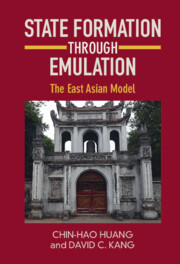Refine search
Actions for selected content:
22 results
Chapter 15 - Emulation and Assimilation
- from Part IV - The Logic of Peasant Consumer Behaviour
-
- Book:
- The Power of Peasant Consumers
- Published online:
- 27 November 2025
- Print publication:
- 11 December 2025, pp 297-320
-
- Chapter
- Export citation
Chapter 6 - Moral Heroism without Virtue in Moral Education
-
- Book:
- Moral Heroism without Virtue
- Published online:
- 23 October 2025
- Print publication:
- 06 November 2025, pp 135-161
-
- Chapter
- Export citation
The Rhetoric of Emulation: Debating Emigrant Enfranchisement in Canada
-
- Journal:
- Canadian Journal of Political Science/Revue canadienne de science politique , First View
- Published online by Cambridge University Press:
- 05 September 2025, pp. 1-25
-
- Article
-
- You have access
- Open access
- HTML
- Export citation
7 - The Small-World Spectrum: Using Small Worlds to Compare Networks
- from Part II - Language
-
- Book:
- Behavioral Network Science
- Published online:
- 08 November 2024
- Print publication:
- 19 December 2024, pp 101-115
-
- Chapter
- Export citation

The Challenges of Born-Digital Fiction
- Editions, Translations, and Emulations
-
- Published online:
- 21 February 2024
- Print publication:
- 21 March 2024
-
- Element
- Export citation
7 - Emulation and Moral Development in De Officiis
- from Part III - Exemplary Ethics
-
-
- Book:
- Cicero's ‘De Officiis'
- Published online:
- 15 June 2023
- Print publication:
- 29 June 2023, pp 139-160
-
- Chapter
- Export citation
1 - Introduction
-
- Book:
- The Authoritarian International
- Published online:
- 11 May 2023
- Print publication:
- 25 May 2023, pp 1-32
-
- Chapter
- Export citation
9 - Luxury Consumption and Elite Lifestyles
- from Part IV - Shared Practices
-
-
- Book:
- Etruria and Anatolia
- Published online:
- 02 March 2023
- Print publication:
- 09 March 2023, pp 166-181
-
- Chapter
- Export citation
1 - Introduction
-
- Book:
- State Formation through Emulation
- Published online:
- 21 July 2022
- Print publication:
- 04 August 2022, pp 1-10
-
- Chapter
- Export citation
8 - Epistemic Communities and Regional Connections
-
- Book:
- State Formation through Emulation
- Published online:
- 21 July 2022
- Print publication:
- 04 August 2022, pp 155-171
-
- Chapter
- Export citation
5 - Phase II
-
- Book:
- State Formation through Emulation
- Published online:
- 21 July 2022
- Print publication:
- 04 August 2022, pp 95-118
-
- Chapter
- Export citation

State Formation through Emulation
- The East Asian Model
-
- Published online:
- 21 July 2022
- Print publication:
- 04 August 2022
Making ProB Compatible with SWI-Prolog
-
- Journal:
- Theory and Practice of Logic Programming / Volume 22 / Issue 5 / September 2022
- Published online by Cambridge University Press:
- 27 June 2022, pp. 755-769
-
- Article
-
- You have access
- Open access
- HTML
- Export citation
Emulating computer experiments of transport infrastructure slope stability using Gaussian processes and Bayesian inference
-
- Journal:
- Data-Centric Engineering / Volume 2 / 2021
- Published online by Cambridge University Press:
- 06 September 2021, e12
-
- Article
-
- You have access
- Open access
- HTML
- Export citation
23 - Social Learning in Chimpanzees
- from Part IV - Social Learning and Teaching
-
-
- Book:
- The Cambridge Handbook of Animal Cognition
- Published online:
- 01 July 2021
- Print publication:
- 22 July 2021, pp 534-558
-
- Chapter
- Export citation
Introduction
-
- Book:
- The Philosophy of Envy
- Published online:
- 01 July 2021
- Print publication:
- 15 July 2021, pp 1-5
-
- Chapter
- Export citation

The Philosophy of Envy
-
- Published online:
- 01 July 2021
- Print publication:
- 15 July 2021
State Formation in Korea and Japan, 400–800 CE: Emulation and Learning, Not Bellicist Competition
-
- Journal:
- International Organization / Volume 76 / Issue 1 / Winter 2022
- Published online by Cambridge University Press:
- 14 May 2021, pp. 1-31
- Print publication:
- Winter 2022
-
- Article
- Export citation
Christocentric Exemplarism and the Imitation of Jesus
-
- Journal:
- New Blackfriars / Volume 101 / Issue 1093 / May 2020
- Published online by Cambridge University Press:
- 01 January 2024, pp. 301-310
- Print publication:
- May 2020
-
- Article
- Export citation
Chapter 3 - Plutarch and Roman Exemplary Ethics
- from Part I - Refiguring Roman and Greek Interactions
-
-
- Book:
- Literature and Culture in the Roman Empire, 96–235
- Published online:
- 28 April 2020
- Print publication:
- 30 April 2020, pp 75-94
-
- Chapter
- Export citation
